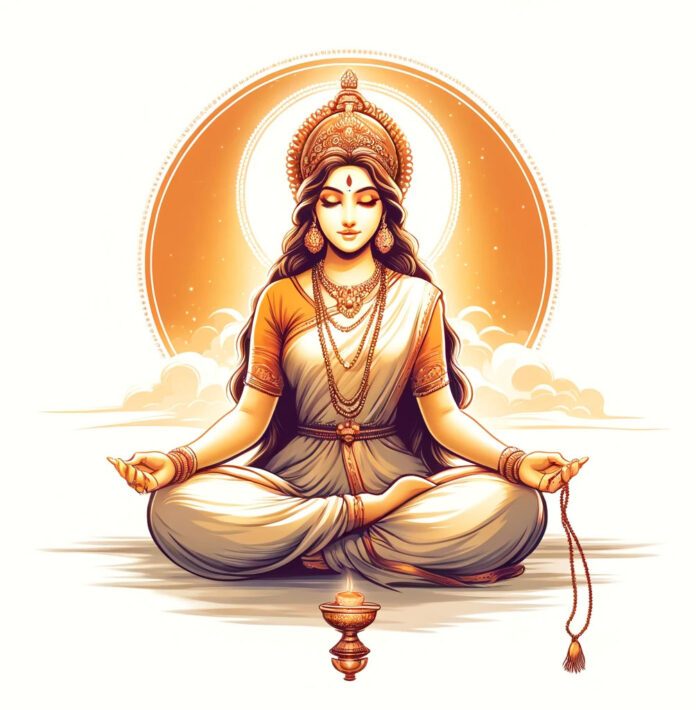Maa Brahmacharini represents unwavering devotion and discipline, worshipped for spiritual strength, ethical conduct, and inner peace.
Maa Brahmacharini, the revered form of Goddess Durga, is worshipped on the second day of Shardiya Navratri. Navratri is a nine-day Hindu festival dedicated to the worship of the nine forms of Goddess Durga, also known as Navdurga. Each day of Navratri celebrates a different form of the Goddess, with special rituals, prayers, and observances. On the second day, devotees worship Maa Brahmacharini, the embodiment of devotion, penance, and discipline.
Significance of Maa Brahmacharini
Maa Brahmacharini represents the unmarried form of Goddess Parvati, who performed intense penance to attain Lord Shiva as her husband. Her name, Brahmacharini, is derived from “Brahma,” which means penance or austerity, and “charini,” meaning one who performs it. This form of the Goddess is symbolic of extreme dedication, renunciation, and the power of perseverance. She is often depicted walking barefoot, holding a jap mala (prayer beads) in her right hand and a kamandal (water pot) in her left hand, symbolizing her spiritual focus and her path of penance.
According to Hindu mythology, Maa Brahmacharini took birth in the home of Daksha Prajapati, the father of Goddess Parvati. After her previous incarnation as Sati, Parvati was reborn with the desire to reunite with Lord Shiva. Determined to marry him, she undertook severe penance for thousands of years. The legends state that she survived on flowers and fruits for the first 1,000 years, followed by a strict diet of leafy vegetables for the next 100 years while sleeping on the floor.
Her penance became even more intense over time. Maa Brahmacharini survived on Bilva leaves for 3,000 years while praying to Lord Shiva. Eventually, she gave up even this minimal sustenance, living without food or water, exhibiting her unwavering devotion and determination. Her relentless penance and devotion pleased Lord Shiva, who agreed to marry her, fulfilling her desire.
Symbolism and Attributes of Maa Brahmacharini
Maa Brahmacharini governs the planet Mars, also known as Mangal, which is considered the provider of fortunes and success. She is known to bestow virtues such as penance, renunciation, dispassion, and self-restraint upon her devotees. Those who worship her are believed to experience an increase in their ethical and moral conduct, and they become more spiritually inclined.
Her simple and austere form serves as a reminder of the strength of devotion, self-discipline, and the pursuit of inner peace. The jap mala in her hand represents the focus on meditation and prayer, while the kamandal symbolizes renunciation and detachment from material desires.
Navratri 2024: Day 2 Timings and Auspicious Color
The second day of Navratri in 2024 falls on October 4. According to Drik Panchang, the Dwitiya tithi (second lunar day) will last until 5:30 AM on October 5. Several auspicious muhurats (time slots) are recommended for performing the rituals and worship on this day:
Brahma Muhurta: 4:38 AM to 5:27 AM
Abhijit Muhurta: 11:46 AM to 12:33 PM
Vijaya Muhurta: 2:07 PM to 2:55 PM
Each day of Navratri is associated with a specific color that holds symbolic significance. On the second day, the color green is considered auspicious. Green represents nature, growth, fertility, and harmony. It evokes a sense of peace and serenity, qualities that are associated with the energy of Maa Brahmacharini.
Devotees often dress in green attire on this day and use green-colored items in the worship rituals to honor the Goddess and invoke her blessings for a life filled with growth, prosperity, and peace.
Puja Vidhi, Samagri, and Bhog for Maa Brahmacharini
The worship of Maa Brahmacharini is a sacred and structured ritual. Devotees begin the day by waking up early during the Brahma muhurta, which is the time just before sunrise, considered highly auspicious for spiritual activities. After bathing and cleansing themselves, they purify the place of worship by sprinkling Gangajal (holy water from the Ganges).
Maa Brahmacharini is worshipped with great devotion, and a kalash (a metal pot) filled with water is placed at the altar as a symbol of purity and life. Jasmine flowers, rice, and sandalwood are offered to the Goddess.
After bathing the idol or image of the deity, the shringaar (decorating the idol) is done. Jasmine flowers, which are sacred to Maa Brahmacharini, are placed before her along with roli (vermilion) and kumkum (red powder), symbolizing respect and devotion.
An important part of the puja involves performing an abhishek (ceremonial bathing) of the deity with milk, curd, and honey.
This is followed by the offering of a special bhog (prasad) made of sugar. It is believed that offering sugar to the Goddess pleases her and brings sweetness into the devotee’s life. The sugar is later distributed among family members as prasad.
Prayers, Mantras, and Stuti for Maa Brahmacharini
During the puja, devotees chant specific mantras and prayers dedicated to Maa Brahmacharini. The prayers invoke her blessings for discipline, strength, and spiritual growth. The following are some of the key prayers and mantras:
Prathana (Prayer):
Dadhana Kara Padmabhyamakshamala Kamandalu
Devi Prasidatu Mayi Brahmacharinyanuttama
This prayer seeks the Goddess’s blessings and expresses devotion to her supreme form of Brahmacharini.
Puja Mantra:
Om Devi Brahmacharinyai Namah
This mantra is chanted to invoke the presence of Maa Brahmacharini during the worship.
Stuti (Praise):
Ya Devi Sarvabhuteshu Maa Brahmacharini Rupena Samsthita
Namastasyai Namastasyai Namastasyai Namo Namah
This stuti is a reverential hymn that glorifies the Goddess in her form as Brahmacharini and pays respect to her.
The Deeper Impact of Worshipping Maa Brahmacharini
The worship of Maa Brahmacharini is believed to bring about significant positive changes in a devotee’s life. Her blessings enhance qualities such as discipline, patience, and commitment, which are essential for both spiritual and worldly success. Devotees who pray to her with sincere devotion find themselves more equipped to handle life’s challenges with inner strength and calmness.
Moreover, Maa Brahmacharini’s association with the planet Mars (Mangal) means that her worship can bring good fortune, resolve conflicts, and improve one’s overall well-being. She helps devotees lead a more balanced life by encouraging restraint, ethical behavior, and dedication to their spiritual path.
Conclusion
Maa Brahmacharini, worshipped on the second day of Navratri, embodies the spirit of unwavering devotion and discipline. Through her penance, she inspires devotees to cultivate inner strength, self-control, and perseverance in their lives.
The rituals, prayers, and offerings made on this day reflect a deep connection to the Goddess and her virtues. By honoring Maa Brahmacharini, devotees seek her blessings for a life filled with peace, harmony, and spiritual growth.






























